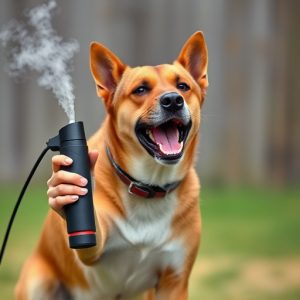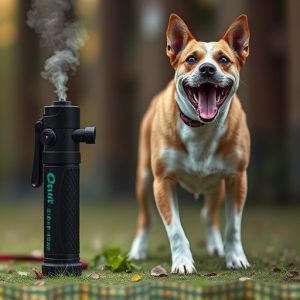Legal Guide: Dog Repellent Sprays, Active Ingredients, and Responsible Use
Animal control sprays, classified as pest control products, are governed by strict environmental reg…….
Animal control sprays, classified as pest control products, are governed by strict environmental regulations with concentration limits and approved application methods for active ingredients like capsaicin and synthetic urine. Local laws vary widely regarding their use, emphasizing responsible application, safety, and minimal environmental impact through proper disposal, crucial for effective dog deterrence while protecting communities and ecosystems.
Animal control sprays have emerged as a popular solution for managing unwanted animal encounters, particularly with dogs. This article explores the legalities surrounding these products, focusing on their active ingredients and safety profiles. We delve into the regulations governing their use, highlighting key considerations for responsible application. From understanding common active ingredients in dog repellent sprays to identifying legal use cases, this guide offers insights for those seeking effective yet compliant animal control solutions.
- Understanding Animal Control Sprays: Legal Framework and Regulations
- Common Active Ingredients in Dog Repellent Sprays: Safety and Efficacy
- When is it Legal to Use Animal Control Spray? Use Cases and Guidelines
- Best Practices for Responsible Application and Disposal of Animal Control Sprays
Understanding Animal Control Sprays: Legal Framework and Regulations
Animal control sprays, particularly dog repellent sprays, are designed to deter and manage unwanted animal interactions. Understanding their legal use is crucial for responsible application and safety. The legality and regulations surrounding these products vary significantly from region to region. In many areas, they are classified as pest control products, subject to strict guidelines set by environmental and health authorities. These regulations often dictate the active ingredients allowed, concentration limits, and approved methods of application.
For instance, popular active ingredients in dog repellent sprays include capsaicin, a compound found in chili peppers, and synthetic urine, which mimics animal scent to deter dogs. The legal framework ensures these products are safe for both animals and humans while effectively addressing animal control issues. It’s essential for users to familiarize themselves with local laws and consult professionals to ensure proper use, avoiding potential harm and environmental impact.
Common Active Ingredients in Dog Repellent Sprays: Safety and Efficacy
Dog repellent sprays are designed to deter canine intrusions, but their effectiveness and safety depend on the active ingredients they contain. Common substances used include capsaicin, which is derived from chili peppers, and synthetic versions of a dog’s natural pheromones. Capsaicin works by stimulating sensory nerves, creating an unpleasant sensation that drives dogs away. It is generally considered safe for both dogs and humans when applied correctly, but it can cause irritation if accidentally touched or inhaled.
Synthetic pheromone sprays mimic the chemical signals that dogs use to communicate, often focusing on the “stress” pheromones that mother dogs produce to calm their puppies. These repellents aim to create an environment where dogs feel uncomfortable and choose to leave. While these methods are generally regarded as humane, their efficacy can vary based on environmental factors and individual dog behavior. Always follow manufacturer instructions and consult local regulations regarding the legal use of such sprays to ensure safety and effectiveness.
When is it Legal to Use Animal Control Spray? Use Cases and Guidelines
The legal use of animal control spray, often known as dog repellent spray, varies significantly by region and jurisdiction. In general, it’s permitted for deterring or controlling dogs in specific situations where public safety or property protection is at risk. For instance, it can be legally employed in areas like parks, backyards, or agricultural fields to keep dogs away from certain spaces.
The active ingredients in dog repellent sprays play a crucial role in their effectiveness and legality. Common active ingredients include capsaicin (derived from chili peppers), which irritates the dog’s nose and eyes, causing them to avoid the treated area. Other ingredients like citronella or garlic-based compounds are also used. It’s important for users to familiarize themselves with local laws and guidelines regarding these sprays, including restrictions on where and how they can be applied to ensure safe and responsible use.
Best Practices for Responsible Application and Disposal of Animal Control Sprays
When applying animal control spray, responsible use is paramount. Start by understanding the active ingredients in dog repellent sprays; common options include capsaicin, a derivative of chili peppers, and synthetic urine, which mimics predator scent to deter dogs. Always follow the product’s instructions for application, ensuring you target specific areas like lawns, gardens, or entry points into your property. Sprays should be applied sparingly, avoiding excessive use to prevent environmental harm and potential health risks.
Disposal is another crucial aspect. Many animal control sprays are designed to degrade naturally over time, but it’s essential to check local regulations for proper disposal methods. Never discharge these products into water bodies or let them contaminate soil. Instead, dispose of empty containers in designated hazardous waste facilities to prevent ecological damage and maintain community safety.
Animal control sprays, with their active ingredients like capsaicin and citric acid, offer effective solutions for managing unwanted animal interactions. Understanding the legal framework and best practices is crucial for responsible use. When applied correctly, these sprays can help protect property and pets while minimizing harm to wildlife. Always follow local regulations and guidelines, ensuring a balance between humane control and environmental safety when considering dog repellent sprays as a last resort.


